Irish Grad Student Discovers Pulsars, But Englishman Gets Nobel
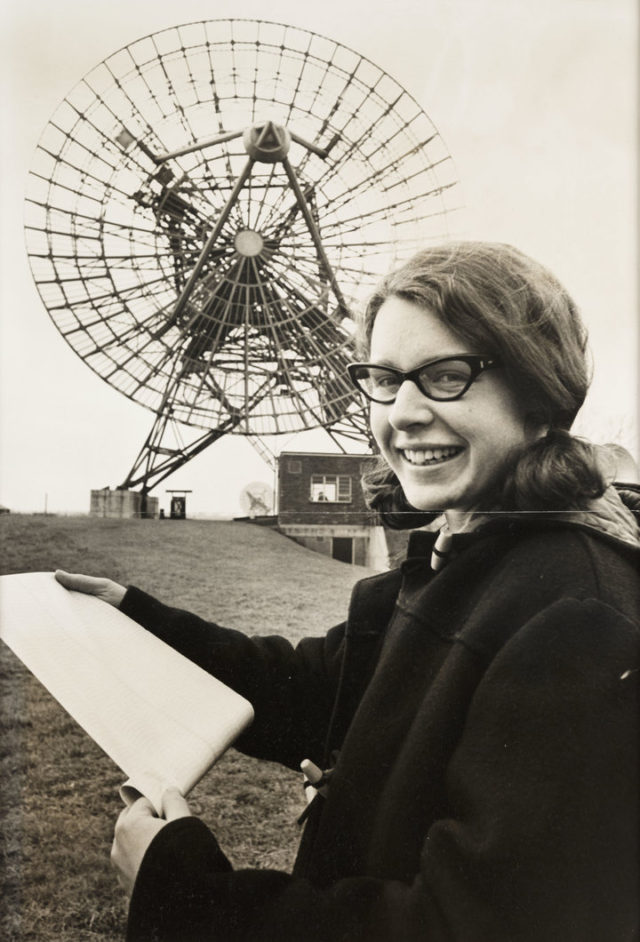 Being of Irish heritage and an astronomer, astrophysicist and educator by profession, I have a particular interest in this story. As a founding member of Astronomy For Change (https://astronomyforchange.org) and the original author, I'm sharing it here on TWG. -- Tom Madigan
Being of Irish heritage and an astronomer, astrophysicist and educator by profession, I have a particular interest in this story. As a founding member of Astronomy For Change (https://astronomyforchange.org) and the original author, I'm sharing it here on TWG. -- Tom Madigan
Left: UNITED KINGDOM - FEBRUARY 23: 'Miss Jocelyn Bell', 1968 A photograph of Jocelyn Bell Burnell at Cambridge University's Mullard Radio Astronomy Observatory, taken for the Daily Herald newspaper in 1968. (Photo credit: Daily Herald Archive/SSPL/Getty Images)
To suffer is to learn humility, true humility.
Jocelyn Bell, no doubt, suffered in silence from the insult and the culture that led to it, one of the greatest professional injustices in modern academia. Given my Irish heritage, I have a particular interest in this story and, although the title could be a trigger or flash point for some, that isn't my intention. The above title is simply a statement of fact and is a key aspect of the story that will be told here, the seminal discovery of Pulsars by Susan Jocelyn Bell [Burnell].
I write this article for the following reasons:
- Tell the story of how Pulsars were discovered, a term considered a "household word" today in the Astrophysical community;
- Address a historically grotesque injustice perpetrated on a humble student who took the moral high road when confronted with the systemic and entrenched sexism in a male-dominated field;
- Chronicle another chapter in the long history of injustice perpetrated on the Irish race;
- Highlight the contribution of Women in science, specifically Astrophysics.
Growing up In the North of Ireland
The oldest of four children, Susan Jocelyn was born to M. Allison and G. Philip Bell in Belfast, (N) Ireland on July 15, 1943 and grew up in Lurgan, County Armagh.
Being born in Belfast and growing up in a veritable war zone of racism, classism, sectarian violence and state-sponsored terrorism, was part and parcel for Irish people living on their land with a foreign flag flying in that province's Capital city. Although the vitriol was primarily reserved for Catholics, the basic tenets of the Quakers, their gentle manner and quiet nature were, no doubt, unpalatable to the sectarian gangs that patrolled the streets of Belfast and greater Armagh. As a side note, the Republic of Ireland (the 26 counties to the south of the political divide that separates what is known today as "Northern Ireland" from the rest of the island), won its independence from Great Britain only 21 years earlier at the time of her birth in 1943. Three of the primary tenets of the Quaker faith are:
- Women are permitted to teach and hold positions
- Social hierarchies were to be disregarded and
- Pacifism was to be followed;
All these tenets are diametrically opposed to the ingrained Monarchistic, Colonialist and Provincial social order of the day in that part of Europe and, no doubt, gave her the tools to overcome much adversity in the pursuit of her degree and her career.
Set against the generally provincial, conservative establishment of the day -a posture that sought to maintain the status quo in the six counties -by any standard, these three tenets would be considered progressive in the sense understood by such leaders as Franklin Delano Roosevelt. They allowed Jocelyn to excel and thrive in school, specifically in science. When the other girls were in Homemaking, she was in the physics lab.
Beginnings and The Discovery of Pulsars
From her humble beginnings, Dr. Bell-Burnell went on to observe radio emissions from pulsars for the first time in history, making one of the most significant discoveries in astronomy of the 20th century.
Jocelyn's father was an architect by profession and, as serendipity would have it, one of his clients was the Armagh Observatory and Planetarium, just down the road from the family home in Lurgan. Being drawn to science and with a strong family cohesion (a character engendered by the Quaker faith), Jocelyn would spend much of her time as a child with her father -and at the Observatory. Of course she would spend hours and days pouring over the astronomy books and literature and, as her interest in the subject grew, she was encouraged by the staff of the Observatory to pursue a career in astronomy. As can be inferred by now, her father played a central role in her choice of careers and lest his influence be overlooked, he designed the Armagh Planetarium!
As she recalls in a recent interview:
I was about 14 years old when my father brought home an astronomy book from the public library by Fred Hoyle called Frontiers of Astronomy. It was quite a tough read for a 14-year-old, but I took it up to my room and read it from cover to cover — I was hooked.
To get a sense of how difficult it was for a woman to make a name for herself in science in the conservative, male-dominated culture she was immersed in, given the restrictions and societal conventions of the day, she recalls the trajectory of her career at the time:
I got married just as I finished my PhD and had a child fairly soon after that. I then spent about 20 years picking up part-time work in any kind of astronomy, near where my husband was working.
It should be pointed out that in 1969, the year she received her degree, the Irish Civil Rights Movement was moving into high gear, a point in time that would begin a 30-year struggle against sectarian violence and strife known as "The Troubles". This period would culminate with the now famous 1998 Good Friday Agreement between the Irish and British governments that provided a power-sharing framework for the six counties. That framework is now in jeopardy with "BrExit" and the six counties of the North voting to remain in the European Union.
As it turns out, the world famous British astronomer Fred Hoyle, author of the book she read cover-to-cover as a 14-year-old, would come to play a positive role in her career as she progressed.
Jocelyn attended Lurgan College and went on to earn a Physics degree from the University of Glasgow in 1965. Four years later in 1969, defending her 243-page dissertation entitled "The Measurement of Radio Source Diameters using a Diffraction Method", she completed her Ph.D at the University of Cambridge. It was there, while conducting her research under the supervision of Antony Hewish, that she constructed and operated the 81.5 megahertz radio telescope that would play a key role in what was to come at the university's Mullard Radio Astronomy Observatory.
Although Dr. Bell-Burnell didn't set out to discover Pulsars (no one ever does), given enough time and her study of external Radio sources, it would ultimately lead to their discovery. And so it did.
Jocelyn was investigating the rapid variation and modulation of radio emissions by the solar wind. In her analysis of the data, she discovered that certain radio sources had precisely timed radio pulses associated with them. Further analysis clearly indicated that these sources were not man-made or terrestrial in origin and that the only sensible explanation was that these “pulsating radio sources”(Pulsa-rs) had their origins in deep space.
Dr. Anthony Hewish was one of the founding members of the Radio Astronomy Group and was doing some pioneering work following advances made in radio technology after World War II. More and more deep radio sources were discovered in the late 1950s, most notably, in 1950, by the Cavendish Astrophysical Group of Cambridge University, formerly known as the Radio Astronomy Group. Initial studies conducted by them clearly show the true nature of QSOs were unknown.
Dr. Bell-Burnell was a graduate student studying under Dr. Hewish, the only two working on this project at Cambridge. Rather than attributing the seemingly incredible discovery that was just made by Dr. Bell-Burnell, Dr. Hewish initially discounted it as most likely a mistake made by her in the cabling or wiring of the radio telescope antenna or electronics. Upon inspection of the recording tape, he was forced to admit that indeed, an incredible discovery has just been made.
Discovery of the First Pulsar
Paper published upon the discovery of the first pulsar 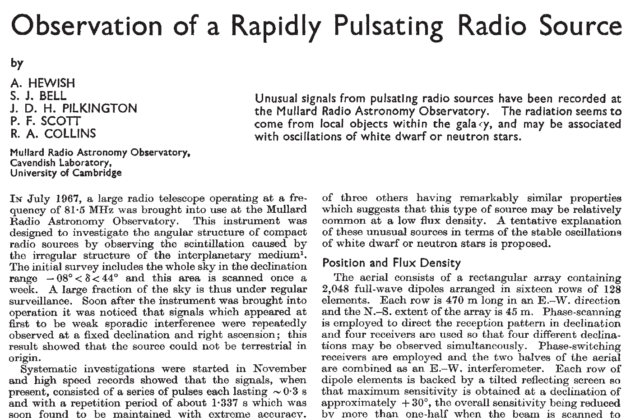
What did the first pulsar data look like?
It was an anomaly, and it was a very small anomaly. Typically it took up about 5 millimeters of my long rolls of chart paper, out of half a kilometer. I was being very, very thorough, very careful. I kept poking at it to try and understand what it was.
The signals was referred to as LGM-1 by Dr. Bell-Burnell, an acronym for 'Little Green Men', implying that the signal may have been alien or intelligent in origin.
That was a bit of a joke, which I now rather regret. But we did check it out. My advisor Tony [Hewish] argued that, if it were little green men as we nicknamed them, they’d probably be on a planet going round their sun. As their planet moved, we would see what’s called Doppler shift. The spacing between pulses would change as their planet moved. We looked for that, but we couldn’t find any such motion.
Rather than describe some of the more salient points in this story, we quote from her most recent video interview featured in the NY Times:
Nobody knew what a pulsar was until I found the first two.
Tony Hewish had this particular project to pick-out compact objects called 'Quasars' [Quasi-stellar radio sources].
It's incredibly hard to get people to believe that you've discovered something amazing when you've only got one.
I think the fact that I was a graduate student and a woman together demoted my standing in terms of receiving a Nobel Prize. It didn't bother me; I was actually pleased. I was really pleased that Pulsars were considered important enough to rate a Nobel Prize.
The very name 'Pulsar' is an abbreviation for 'Pulsating Radio Star'. It's the remains of a big star that exploded near the end of its life. And this tiny star is spinning and, as it spins, it sweeps a radio wave around the sky and if it shines in your face, you see 'pulse', 'pulse', etc..but if it doesn't shine in your face, you don't see anything.
I've actually had 'huge fun' in my career even if it hasn't been a string of prestigious jobs, it's been a string of very, very interesting jobs usually working in great places with great colleagues.
July, 2018, I had a phone call from Ed Witten, whose a very eminent Princeton Physicist, that I'd won this 'Breakthrough Prize' for the discovery of Pulsars.
The reason I discovered Pulsars was because I was a bit of an outsider who felt...maybe not entitled to be there and I thought that if I could give more minority people an opportunity to do Ph.Ds, some exciting things might emerge. Phone up the chief executive of the Institute of Physics and say 'Hello, Paul', could the Institute of Physics use a 3 Million dollar award to provide research studentship for people from minorities? And he didn't hesitate....he said 'Yes!'
Fred Hoyle influenced me and turned me on to Astronomy. It's important to be a good role model. I do think it's important that there are role models for young women so, ok, I'll be it [the role model].
And what a role model she is!
The Nobel Prize She Didn't Receive and Her Gift to Princeton's Institute for Advanced Study
Having won the 2018 Breakthrough Prize in Fundamental Physics for the discovery of..., she was now in a position to help others avoid some of the same pitfalls and systemic bias that she endured since 1967. She thus donated the entire prize to the Princeton Institute of Physics (The Institute for Advanced Study) with the express purpose of funding women, under-represented ethnic minorities and refugee students to pursue careers in Physics as researchers.
Hoyle's seminal work on Stellar Nucleosynthesis of the elements led to the 1983 Nobel Prize in Physics being awarded to Hoyle's collaborator, William Fowler, not Hoyle, no doubt out of spite. Set against that, nine years earlier, the Royal Swedish Academy of Sciences previously awarded the 1974 Nobel Prize in Physics to Anthony Hewish and Martin Ryle for the discovery of Pulsars, not Dr. Bell-Burnell. This injustice Fred Hoyle took vocal exception to, something that may have led to his losing the opportunity to receive the 1983 Nobel. Following that he and Anthony Hewish, Dr. Bell-Burnell's Ph.D advisor, became fierce enemies.
Succumbing to myelodysplasia, a form of anemia also known as pre-leukemia syndrome, Carl Sagan has been gone since 1996.
His timeless words ring as clear and as true now as they did in 1994, exemplified in the actions of Dr. Bell-Burnell with her gift of $3 Million to The Princeton Insti... and gives one insight into her character, having suffered the indignity she did. Considering Dr. Bell-Burnell as an accomplished Astronomer, it is proper and fitting that we reflect on Carl Sagan (another accomplished astronomer) and his famous words within this discussion. Over the course of her life and career, ever since that grotesque insult in 1974 she suffered first, at the hands of the Nobel Committee and second, her adviser, Dr. Anthony Hewish, her humility and depth of character can be no better expressed than with the following passage from Sagan's Pale Blue Dot:
It has been said that astronomy is a humbling and character-building experience. There is perhaps no better demonstration of the folly of human conceits than this distant image of our tiny world. To me, it underscores our responsibility to deal more kindly with one another and to preserve and cherish the pale blue dot, the only home we've ever known.
In academia, your thesis supervisor and advisor is first, your advocate. This person is trusted to provide guidance and support not just within your particular program of study but to advocate on your behalf. They are not to use your idea, work, study and effort as a means to advance their professional interests, something Anthony Hewish and Martin Ryle did. That insult predates Sagan's words by 20 years. Regardless if she read Sagan's timeless words, her formation as a person of integrity, brilliance and high moral character led her to take the high road in response to this injustice. Her ability to cope and see the situation in a different and more positive light, her resilience to it and the provincial culture of the day that gave rise to it was perhaps in her DNA. Not only did she rise above what could have been a career-ending experience for some, she went on in 2018 to donate her Breakthrough Prize to The Institute of Advanced Study in Princeton.
In her own words, her reaction to not being included or mentioned in the 1974 Nobel Prize in Physics:
At that stage, the image people had of science was of a senior man, and it always was a man, with a fleet of younger people working for him. And if the project went well, the man got praise. If the project went badly, the man got the blame. The younger people working under him were isolated from all of that. It seemed to me to be part of that pattern of doing things. I think the Nobel Prize is still fairly male orientated. The world is now making strenuous efforts to be more inclusive. Prizes like the Nobel tend to go to the most senior people, so that will reflect how the society was when they were young and active. It’s going to be some time until changes percolate to the senior prizes.
Supernovae and the Crab Nebula Pulsar
There are two fundamental types of supernovae and we've discussed them and their aftermath extensively in our articles.
- A Type I supernova results when a parasitic white dwarf eventually accretes enough material onto itself to exceed the Chandrasekhar mass and end its life as a Type Ia supernova.
- A Type II, Core-collapse supernova results when a star above 8 solar masses depletes all thermonuclear fuel, collapses in on itself and rebounds, ending its life in spectacular fashion. The progenitor star's mass will determine what happens next. It is either obliterated completely or leaves behind a black hole or a rapidly rotating neutron star. This last case is what we refer to as a Pulsar.
An excerpt from our previous article on nuclear energy:
All elements in the Periodic Table beyond Helium up through Uranium are synthesized in the cores of stars. In the case of our sun, hundreds of millions of metric tons of hydrogen, through nuclear fusion reactions in its core, are continuously transmuted through nucleosynthesis to form Helium, releasing enormous amounts of energy according to the principle of Mass-Energy Equivalence (E=mc²) first derived by Einstein in 1905. The heavier elements, above Iron through Uranium are only produced in the aftermath of supernovae, the spectacular end to high-mass stars or, alternatively, the spectacular end of a White Dwarf star in a Type-Ia supernova.
Supernovae (plural of Supernova) are thus, the progenitors of Neutron Stars and Pulsars.
The Crab Nebula (M-1) as imaged with the Hubble Space Telescope.[/caption] A famous supernova remnant is the Crab Nebula, first observed on July 4, 1054 by Chinese astronomers in the Constellation Taurus. This author and other educators use it as a model to teach from. It has been widely studied and can be used as an example of a supernova remnant and the power-energy interplay between the nebula and the "Crab Nebula Pulsar", a rapidly rotating neutron star rotating once every 331/10000 of a second or 30.2 times every second.
Understanding a pulsar to be the core of the supernova's progenitor star, it's rotational kinetic energy was imparted as a result of the progenitor star's explosion. There are few events in all of nature that come close to the energy released during a supernova. That energy spins up the pulsar immediately following the explosion and is the power driving the Crab Nebula's emission today.
Advanced high school physics students can thus determine many of its physical properties after learning that the energy source powering the nebula is the "Crab Nebula Pulsar". The rotational kinetic energy of the pulsar, its energy of motion, directly translates into the nebula's luminosity across all wavebands of the electromagnetic spectrum. Using the nebula's total radiated power of 5 x 1031 Watts, we can calculate the:
1. Pulsar's Moment of Inertia (a physical quantity describing how easily a body can be rotated about a given axis, the rotational analogue of mass, describing an object's resistance to translational motion);
2. Pulsar's (neutron star's) radius and density given its mass of 1.4 solar or 2.8 x 1030kg from theory: 10 Kilometers with a density of 6.2 x 1017kg/m3, exceeding that of an atomic nucleus.
The light captured by our telescopes and cameras had its origin as the pulsar's rotational kinetic energy. As a result of this energy drain, the pulsar is slowly spinning down at a rate of 4.22 x 10-13 seconds every second. At the close of this year, 2021, the pulsar will have completed 922.4 billion rotations, having slowed down a mere 128/1000 of a second in the intervening 967 years since the supernova.
What Are Pulsars?
A Pulsar is a rapidly rotating neutron star, the remnant of what was once the core of a high-mass star. So, how does a Pulsar 'Pulse'? As can be inferred from the quote by Dr. Bell-Burnell above, a tightly-focused beam of radio energy is swept out on the sky as the pulsar rotates. What causes that beam in the first place and is that related to the original supernova explosion? One of the properties of the Pulsar/Neutron Star is an enormous magnetic field. Basic Electrodynamics teaches us that electrons flowing in a magnetic field will emit electromagnetic radiation with a frequency proportional to their velocity in the field. The magnetic field serves two purposes:
- The electrons flowing along the rotating pulsar's magnetic field lines are the source of this radio emission
- The magnetic field tightly focuses that radio energy in a concentrated beam
The properties of the neutron star were finalized in the last moments of the high-mass star's life. As the mass of the star's outer core collapsed in on the inner core, the neutron star's properties were literally 'etched in stone'. The properties remained intact following the supernova and are the cause of what we observe today.
The orientation of the beam was determined by the supernova blast and could best be described as random. Once established however, the axis of rotation will remain fixed unless something else comes along to change it (Newton's first law of motion).
Current Status
Chancellor, The University of Dundee, Scotland Visiting Professor at Mansfield College, University of Oxford
Update: four days ago on 25 August, Dr. Bell-Burnell was awarded the Copley Medal, the world’s oldest scientific prize and has added the 25,000 Pound prize money to her donation to the Institute For Advanced Study.
Related Sources and Documents
Published in the February 24, 1968 issue of Nature is one of the first papers to emerge from Dr. Bell-Burnell's Ph.D research: Observation of a Rapidly Rotating Radio Source Fred Hoyle's 1955 seminal work "Frontiers of Astronomy" is now in the public domain and is included here as a pdf or an internet archive article. Excerpts from the author's recent paper on Quasars and Pulsars:
Cambridge
Following Jansky’ work in the mid 1930’s, fast forward 15 years to 1950, Cambridge, England. A tremendous about of work was done by astronomers at the University of Cambridge at what is today known as the Cavendish Astrophysical Laboratory.
Formerly known as the Radio Astronomy Group, this group retains the title of the Cavendish Astrophysical Group. With the advances made in radio technology following World War II, more and more deep radio sources were discovered in the late 1950s, most notably, in 1950,by the Cavendish Astrophysical Group of Cambridge University. Initial studies conducted by them clearly show the true nature of QSOs were unknown.
The first observations of these radio sources, known first as the 1C, or 1st Cambridge catalogue, studied 50 discrete radio sources in the northern hemisphere at 81.5 MHz. This “1C” catalogue came to be known as “A preliminary survey of the radio stars in the Northern Hemisphere”. This study, although providing an alternative that would suggest that these QSOs are extragalactic, shows that the authors were clearly convinced that QSOs were local and resided within the Milky Way {AC}. Following publication of the 1C study, subsequent successful studies by the Cambridge astronomers followed.
Of particular note is the 3C catalog (3C designating the Third Cambridge Catalog of Radio Sources, a compendium of radio sources containing 3C-273, the first object to be identified as a quasar, the brightest and the closest of the quasars and one of the first to be identified with an optical counterpart. Originally published in 1959, revised in 1962 and further revised and completed in 1983 by Laing, Riley and Longair to remove duplicate and specious entries and to add others, the 3C catalogue is one of the most widely referenced and well known of the catalogues published and maintained by the Cambridge group. It should be clarified why, since 3C-273 was the first object identified as a quasar, it has a catalog reference of 273. The 3C catalog (as well as the others) is ordered by Right Ascension; there are 272 entries in the catalog with Right Ascensions further east.Jocelyn Bell, Anthony Hewish and the Cambridge Radio Astronomy Group
Having remarked on the contributions of Women in Astronomy, specifically on the contributions of Henrietta Leavitt, it is worth noting while discussing the contributions of the Cavendish Astrophysical Group and Cambridge University, that another woman, Jocelyn Bell, discovered another rather remarkable phenomenon. Jocelyn was a graduate student in 1967, working under Anthony Hewish, one of the founding members of the Radio Astronomy Group and winner of the 1974 Nobel Prize in Physics.
As is often the case with scientific discovery and, more specifically with astronomy, serendipity played a major role in what would later become another seminal discovery. Jocelyn was investigating the rapid variation and modulation of radio emissions by the solar wind. In her analysis of the data, she discovered that certain radio sources had precisely timed radio pulses associated with them. Further analysis clearly indicated that these sources were not man-made or terrestrial in origin and that the only sensible explanation was that these “pulsating radio sources”(Pulsa-rs) had their origins in deep space.
Because of the precisely timed pulses, with a duration of 0.016 seconds and a frequency of 1.33730115 seconds, they were originally thought to be intelligent in origin and were thus called LGMs for “Little Green Men”. Thinking that they had made what could be thought of as the most historically significant discovery of all time, a hush of secrecy went into effect throughout the lab. After further analysis of new data and much to the relief of all parties involved, it was discovered that the frequency and duration was increasing slightly with time, a discovery that was consistent with a rapidly rotating, natural source whose rotational velocity was gradually decreasing.
After the discovery of additional pulsating sources, it was realized that they discovered a band new astrophysical phenomenon, a discovery that would earn Anthony Hewish and Martin Ryle the Nobel Prize in Physics and Jocelyn Bell nothing, not even an honorable mention either in the published study or by the Nobel Committee.This newly discovered class of object would later become known as a Pulsar, a strongly emitting (in many wavebands, for some) and rapidly rotating neutron star. Although it was Jocelyn’s discovery of the phenomenon that provided the basis for Hewish’s work, she was never recognized professionally for her contribution, something that Hewish’s fellow astronomer, Fred Hoyle, roundly condemned (and rightly so). As would be expected of a person of her caliber, Jocelyn overlooked the insult, at least outwardly, and went on to a highly successful career as an X-Ray astronomer.
The Wild Geese Shop
Get your Wild Geese merch here ... shirts, hats, sweatshirts, mugs, and more at The Wild Geese Shop.
Irish Heritage Partnership
Adverts
Extend your reach with The Wild Geese Irish Heritage Partnership.
Top Content
Videos
© 2025 Created by Gerry Regan.
Powered by
![]()
Badges | Report an Issue | Privacy Policy | Terms of Service
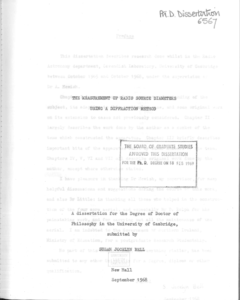
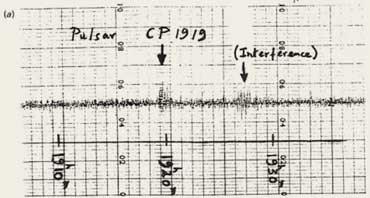
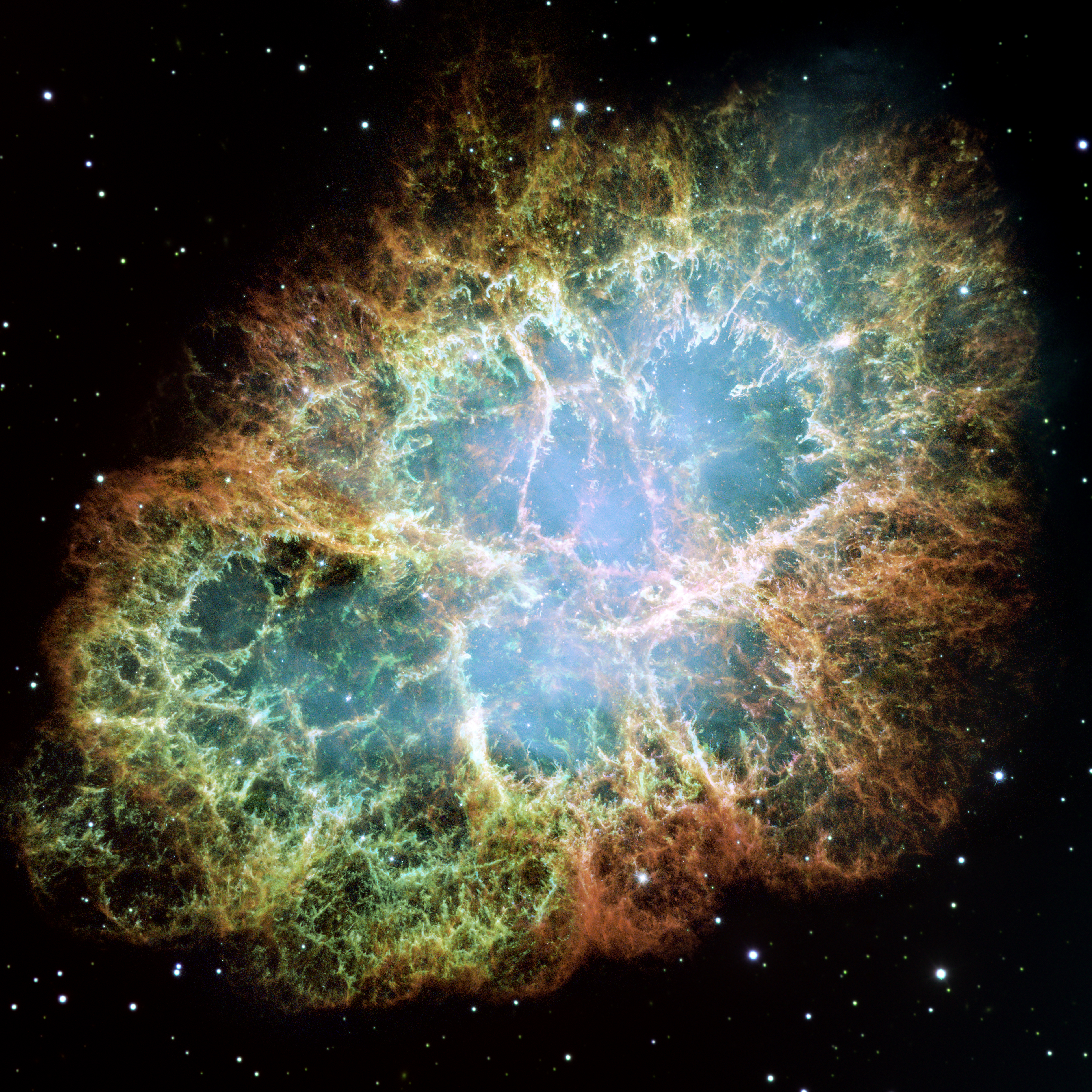
You need to be a member of The Wild Geese to add comments!
Join The Wild Geese